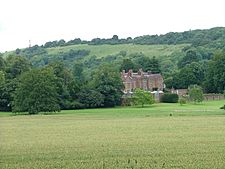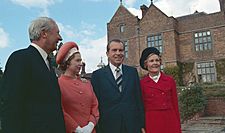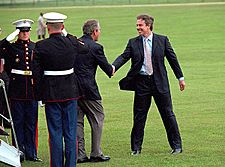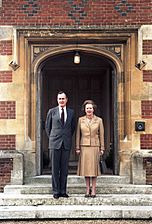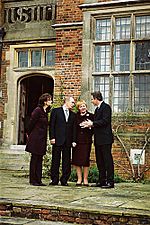Chequers facts for kids
Quick facts for kids Chequers |
|
|---|---|
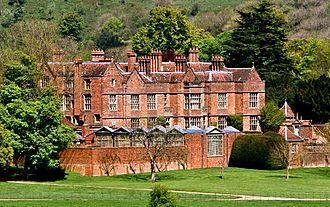
Chequers – the official country residence of British Prime Ministers since 1921
|
|
| Alternative names | Chequers Court |
| General information | |
| Status | Complete |
| Type | Official residence (weekend home) |
| Architectural style | Elizabethan |
| Address | Missenden Road Aylesbury Buckinghamshire HP17 0UZ |
| Country | England, United Kingdom |
| Coordinates | 51°44′36″N 0°46′55″W / 51.74333°N 0.78194°W |
| Current tenants | Prime Minister of the United Kingdom |
| Completed | c. 1556 |
| Client | William Hawtrey |
| Owner | The Chequers Trust |
| Technical details | |
| Material | Red brick with stone dressings and roof tiles |
|
Listed Building – Grade I
|
|
| Official name | Chequers |
| Designated | 21 June 1955 |
| Reference no. | 1125879 |
| Official name | Chequers |
| Designated | 30 August 1987 |
| Reference no. | 1000595 |
| Grade | I |
Chequers (pronounced CHEK-ərz), also known as Chequers Court, is a special country house in England. It's where the Prime Minister of the United Kingdom goes to relax and work away from central London. This old house was built around the 1500s. It's located in Buckinghamshire, England, near the beautiful Chiltern Hills.
Chequers is about 64 kilometers (40 miles) northwest of central London. A nearby place called Coombe Hill used to be part of the Chequers estate. Since 1921, Chequers has been the official country home for the Prime Minister. It was given to the nation by Sir Arthur Lee through a special law called the Chequers Estate Act 1917. The house is considered very important and is listed as a Grade I building on the National Heritage List for England.
Contents
What's in a Name? The Story of Chequers
The name "Chequers" might come from a very old owner of the land. In the 1100s, a man named Elias Ostiarius lived there. He worked for the King's money department, called the Exchequer. The word "Ostiarius" meant an usher, and scacchiera means a chessboard in Italian.
Elias Ostiarius had a coat of arms that looked like a chessboard. So, the estate might have been named after his job and his family symbol. His family, the Scaccarios (spelled in many ways), owned the house for a long time. Later, it passed to the D'Awtrey family, whose name became Hawtrey.
Another idea is that the house was named after chequer trees. These trees (Sorbus torminalis) grow in the area around Chequers.
A Look Back: Chequers Through Time
William Hawtrey built the main part of the house we see today around 1565. He might have rebuilt an older house that was already there. One of the rooms in the house is still named after him.
Soon after it was built, Chequers became a temporary home for Lady Mary Grey. She was the younger sister of Lady Jane Grey and a great-granddaughter of King Henry VII. Lady Mary had married without Queen Elizabeth I's permission. As a punishment, she was sent away from court and kept at Chequers for two years. The room where she stayed from 1565 to 1567 still looks much like it did back then.
Over the years, the house was passed down through different families through marriages. These included the Wooleys, the Crokes, and the Thurbanes. In 1715, the owner of Chequers married John Russell, who was a grandson of Oliver Cromwell. Because of this connection, Chequers still has a large collection of items that belonged to Oliver Cromwell.
In the 1800s, the Russell family made some changes to the house. They tried to make it look like a Gothic castle. They removed old Tudor parts and added battlements and spires. But by the end of the 1800s, the house went to the Astley family. Bertram Astley decided to bring the house back to its original Elizabethan style. He worked with experts like Sir Reginald Blomfield and architect John Birch to restore it.
Chequers in the 20th Century
In 1909, Arthur Lee and his wife Ruth rented Chequers. Ruth was a wealthy American. Arthur Lee immediately started another restoration of the inside of the house. At the same time, Henry Avray Tipping designed several beautiful walled gardens around the house between 1911 and 1912. In 1912, Ruth Lee and her sister bought the property and later gave it to Arthur Lee.
During the First World War, Chequers was used as a hospital. Then it became a place where injured officers could recover. After the war, it became a private home again. The Lees, who had no children, had an idea. Before this time, Prime Ministers usually came from wealthy families who owned large country homes. But after the First World War, new types of politicians were becoming Prime Ministers. They didn't have big country houses to host important guests or to relax.
After talking with the Prime Minister at the time, David Lloyd George, the Lees decided to give Chequers to the nation. They wanted it to be a country retreat for future Prime Ministers. This gift was made official by the Chequers Estate Act 1917.
Lord and Lady Lee of Fareham left Chequers on January 8, 1921. A special stained glass window in the house has a message from them:
This house of peace and ancient memories was given to England as a thank-offering for her deliverance in the great war of 1914–1918 as a place of rest and recreation for her Prime Ministers for ever.
Chequers holds one of the biggest collections of art and items related to Oliver Cromwell in the country. It also has many other old national treasures and books, kept in the famous "long room." This includes a diary from Admiral Lord Nelson. However, these collections are not open to the public.
Nearby Coombe Hill was part of the Chequers estate until the 1920s. It was then given to the National Trust. Both Coombe Hill and the Chequers Estate are part of the Chilterns Area of Outstanding Natural Beauty. This area was recognized for its natural beauty in 1965. The gardens and woodlands around Chequers are also listed as important historic parks.
During the early part of the Second World War, it was thought that Chequers wasn't safe enough for the Prime Minister, Winston Churchill. So, he used Ditchley in Oxfordshire until late 1942. By then, the road leading to Chequers had been hidden from the sky, and other security measures were in place.
When Neville Chamberlain was Prime Minister, Chequers only had one telephone, which was in the kitchen. But Churchill "at once installed a whole battery on his desk," according to Marshal of the Royal Air Force Lord Portal of Hungerford.
Chequers in the 21st Century
On June 1, 2007, the Chequers estate became a protected site. This means it is against the law to enter the estate without permission. In July 2018, Prime Minister Theresa May held an important meeting at Chequers. Her government ministers met there to decide on the UK's plan for leaving the European Union, which became known as the "Chequers plan." In April 2020, Prime Minister Boris Johnson recovered at Chequers after being in the hospital with COVID-19.
Why Chequers Was Given to the Nation
Sir Arthur Lee gave the Chequers estate to the nation after talking with Prime Minister David Lloyd George. Lee realized that future Prime Ministers might not have large country homes. These homes were important for leaders to relax and host foreign guests. The Chequers Estate Act 1917 explains his reasons for this generous gift:
It is not possible to foresee or foretell from what classes or conditions of life the future wielders of power in this country will be drawn. Some may be as in the past men of wealth and famous descent; some may belong to the world of trade and business; others may spring from the ranks of the manual toilers. To none of these in the midst of their strenuous and responsible labours could the spirit and anodyne of Chequers do anything but good. In the city-bred man especially, the periodic contact with the most typical rural life would create and preserve a just sense of proportion between the claims of town and country. To the revolutionary statesman the antiquity and calm tenacity of Chequers and its annals might suggest some saving virtues in the continuity of English history and exercise a check upon too hasty upheavals, whilst even the most reactionary could scarcely be insensible to the spirit of human freedom which permeates the countryside of Hampden, Burke and Milton.
Apart from these more subtle influences, the better the health of our rulers the more sanely will they rule and the inducement to spend two days a week in the high and pure air of the Chiltern hills and woods will, it is hoped, benefit the nation as well as its chosen leaders. The main features of this scheme are therefore designed not merely to make Chequers available as the official country residence of the Prime Minister of the day, but to tempt him to visit it regularly and to make it possible for him to live there, even though his income should be limited to his salary.
Lee believed that Chequers would be good for all future Prime Ministers. He thought it would help them stay healthy and make good decisions. He wanted them to have a peaceful place to escape the busy city life. He also hoped the history of Chequers would remind them of England's long story.
Where is Chequers Located?
Chequers is about 66 kilometers (41 miles) from Downing Street in London. The drive usually takes about an hour and a half.
A famous walking path called The Ridgeway National Trail crosses the private road leading to Chequers.
Images for kids
-
Queen Elizabeth II and Edward Heath with Richard and Pat Nixon, 1970
-
Tony Blair welcomes U.S. President George W. Bush to Chequers, 19 July 2001
-
Margaret Thatcher and George H. W. Bush at Chequers, 12 February 1984
-
Tony and Cherie Blair with Vladimir Putin and Lyudmila Putina, 21 December 2001
See also
 In Spanish: Chequers para niños
In Spanish: Chequers para niños
- 10 Downing Street – the Prime Minister's London office and home.
- Chevening – the British Foreign Secretary's country home.
- Dorneywood – another country house used by important British officials.
- Camp David – the country retreat of the President of the United States.
- Harrington Lake – the country retreat of the Prime Minister of Canada.
- List of official residences – a list of other official homes.
- Windsor Castle – the Royal Family's country home.



